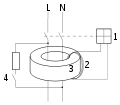
Back Sızma cərəyanından mühafizə avtomatı AZ Диференциалнотокова защита Bulgarian Interruptor diferencial Catalan Proudový chránič Czech Fejlstrømsafbryder Danish Fehlerstrom-Schutzschalter German Interruptor diferencial Spanish Rikkevoolukaitselüliti ET Etengailu diferentzial EU کلید محافظ جان FA

| Electrical installations |
|---|
| Wiring practice by region or country |
| Regulation of electrical installations |
| Cabling and accessories |
| Switching and protection devices |
A residual-current device (RCD), residual-current circuit breaker (RCCB) or ground fault circuit interrupter (GFCI)[a] is an electrical safety device that interrupts an electrical circuit when the current passing through a conductor is not equal and opposite in both directions, therefore indicating leakage current to ground or current flowing to another powered conductor. The device's purpose is to reduce the severity of injury caused by an electric shock.[1] This type of circuit interrupter cannot protect a person who touches both circuit conductors at the same time, since it then cannot distinguish normal current from that passing through a person.[2]
If the RCD device has additional overcurrent protection integrated in the same device, it is referred to as RCBO. An earth leakage circuit breaker may be an RCD, although an older type of voltage-operated earth leakage circuit breaker (ELCB) also exists.
These devices are designed to quickly interrupt the protected circuit when it detects that the electric current is unbalanced between the supply and return conductors of the circuit. Any difference between the currents in these conductors indicates leakage current, which presents a shock hazard. Alternating 60 Hz current above 20 mA (0.020 amperes) through the human body is potentially sufficient to cause cardiac arrest or serious harm if it persists for more than a small fraction of a second. RCDs are designed to disconnect the conducting wires ("trip") quickly enough to potentially prevent serious injury to humans, and to prevent damage to electrical devices.
RCDs are testable and resettable devices—a test button safely creates a small leakage condition, and another button resets the conductors after a fault condition has been cleared. Some RCDs disconnect both the energized and return conductors upon a fault (double pole), while a single pole RCD only disconnects the energized conductor. If the fault has left the return wire "floating" or not at its expected ground potential for any reason, then a single-pole RCD will leave this conductor still connected to the circuit when it detects the fault.
-
A two-pole, or double-pole, residual-current device. The test button and connect/disconnect switch are colored blue. A fault will trigger the switch to its off (down) position, which in this device would disconnect both conductors.
-
1: Electromagnet with help electronics
2: Current transformer secondary winding
3: Transformer core
4: Test push-button
L: Line conductor
N: Neutral conductor
Cite error: There are <ref group=lower-alpha> tags or {{efn}} templates on this page, but the references will not show without a {{reflist|group=lower-alpha}} template or {{notelist}} template (see the help page).
- ^ "Construction eTool | Electrical Incidents - Ground-fault Circuit Interrupters (GFCI) | Occupational Safety and Health Administration". www.osha.gov. Retrieved 2019-04-05.
- ^ Philip Coombs Knapp, Accidents from the Electric Current: A Contribution to the Study of the Action of Current: of High Potential Upon the Human Organism. Damrell & Upham, 1890, page 13
- ^ Weineng Wang, Zhiqiang Wang, Xiao Peng, Effects of the Earth Current Frequency and Distortion on Residual Current Devices, Scientific Journal of Control Engineering, Dec 2013, Vol. 3, Issue 6, p. 417–422.

![Log–log graph of the effect of alternating current I of duration T passing from left hand to feet as defined in IEC 60479-1[3]](http://upload.wikimedia.org/wikipedia/commons/thumb/7/7f/IEC_TS_60479-1_electric_shock_graph.svg/120px-IEC_TS_60479-1_electric_shock_graph.svg.png)
